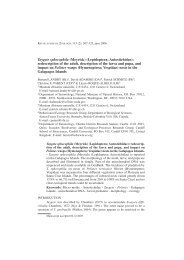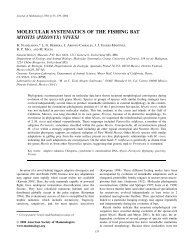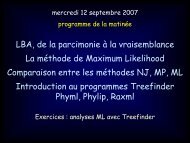Molecular phylogeny of large miliolid foraminifera - University of ...
Molecular phylogeny of large miliolid foraminifera - University of ...
Molecular phylogeny of large miliolid foraminifera - University of ...
Create successful ePaper yourself
Turn your PDF publications into a flip-book with our unique Google optimized e-Paper software.
66M. Holzmann et al. / Marine Micropaleontology 43 2001) 57±74Fig. 3. Phylogenetic tree based on the complete SSU rRNA gene <strong>of</strong> two alveolinid genera and eleven soritacean genera using maximumparsimony analysis. 814 out <strong>of</strong> 3006 sites are parsimony-informative. The total length <strong>of</strong> the most parsimonous tree is 2719, which equals thelength <strong>of</strong> the best tree overall. Ci and ri indices are 0.5355 and 0.5069, respectively. The tree is rooted in Alveolinidae. Bootstrap values arebased on 100 resampling.3. Results3.1. Sequence dataThe complete SSU rRNA gene was sequenced for23 specimens <strong>of</strong> Soritacea and 2 specimen AlveolinidaeTable 1). The length <strong>of</strong> the sequences rangesfrom 2126 to 2744 basepairs bp), which is aboutone and a half as much as in other eukaryotes. Thisunusual length results from several insertions inconserved regions <strong>of</strong> the gene that are unique to <strong>foraminifera</strong>.The sequences <strong>of</strong> Soritacea and Alveolinidae,however, are relatively short compared to other<strong>foraminifera</strong>l species, where the length <strong>of</strong> the SSUrDNA easily exceeds 3000 bp Pawlowski, 2000).The G 1 C content is low and ranges from 27.5 to30.6%. Miliolida in general are among those <strong>foraminifera</strong>lgroups with the lowest G 1 C content,30%), a fact that is due to long series <strong>of</strong> A 1 Tinexpansion segments.For 15 specimens <strong>of</strong> Soritinae, partial SSU rDNAsequences were obtained Table 1). The sequencescontain between 814 and 1018 bp, their G 1 C contentranges from 28.9 to 31.8%. They correspond to the 3 0terminal region <strong>of</strong> Rattus norvegicus K-01593) startingat the position 1181 and ending at position 1871Table 3). The examined fragment includes six variableregions, among them, region I corresponds to theuniversal variable region V6 <strong>of</strong> the prokaryoticsecondary structure model Neefs et al., 1993).






